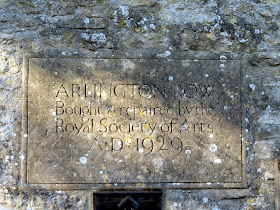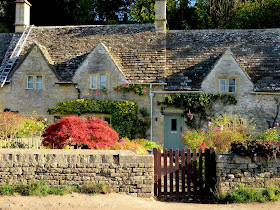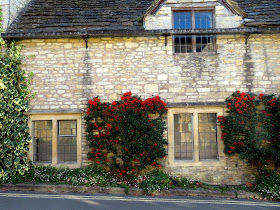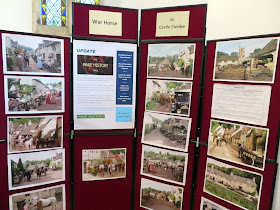Stow means resting place and Wold means unforested, rolling countryside. It is the highest point in the Cotswolds and like the other towns we visited, a market town that was once dependent on sheep. Kate Winslet is one of the more well known actors who call Stow-on-the-Wold home.
One factor I found particularly interesting here were the extremely narrow alleys. One could stand in the middle, both arms out to the side and touch the walls.
These were designed so that farmers could herd their sheep to market. Because the alleys were so narrow the sheep could go only one by one and it made it easier to count them.
This was our lunch stop. I picked Huffkins Tea Room for a "Burford Tea."
This consisted of a scone, an egg mayo sandwich and tea.
There was time to wander about a bit too. I found a thrift shop and bought a couple of very pretty scarves!
Stow-on-the-Wold was the site of an uprising between the Royalists and the Parliamentarians in 1646 and Colin happily told us that the streets were "rivers of blood."
This will go down as the town where Jeanie became a bad blogger. I thought I had plenty on my camera battery -- I didn't. So the next two towns remain relatively unrecorded.
The first of those is Bourton-on-the-Water. Known as the "Venice of the Cotswolds" it is set on a large canal with loads of pretty bridges.
It was a lovely town. I wish I'd had time to do a little more exploring!
Especially this...pretty cute entry to a motoring museum!
Back on the bus and through some more beautiful countryside. I wonder if anything is more lovely than England in autumn.
Our next stop was Tetbury. A "bury" is a fortress and Tet was wither the name of the sister of the King of Wessex back inthe day or the Celtic word for space. The town has a large Market Cross in the center which was very big for the wool industry from the 16th century until the indistry declined in the 18th century. Markets, however, are still held here.
Prince Charles has his home, Highgrove, at Tetbury and we drove by it. The gates were very low key. Apparently the gardens are open for tours in the summer. Maybe next time! But we did stop at the Highgrove shop, which sells items produced by those in the Duchy of Cornwall. There were loads of very beautiful items. Priced for a prince! (I have to admit, I found Charles' watercolors quite appealing but out of my budget range!) I also found a fun antique store and though I didn't buy anything it was fun to see different types of items than what we see here.
We also passed by Badminton House, a noted residence of the Duke of Beaufort and a hunting pal of Charles and Camilla. The property is known for the Badminton Horse Trials and associated with fox hunting. The Beaufort Hunt is considered one of the most famous hunts in the UK. Although foxes are no longer hunted, pheasant shoots continue.
The it was back to Bath. By this time, we all felt like old friends and were delighted with our tour, the sights and our purchases. It was fun to just sit back and watch the lovely scenery roll by.

And after a short walk to the station from the Abbey Hotel, where the day had started, I caught the bus home and climbed up our little hill. Rick had been on a cycle ride that day and we shared stories over a bottle of wine carted around since Paris and some wonderful pasta.
Yes, all the way from France!
I can't say enough how delighted our tour group was with Mad Max Tours and particularly with Colin, our driver. No financial compensation for me here, but I would recommend them to future travelers who are staying a bit in Bath.
Next time we'll hit one of the most well known attractions in Bath and for my money, one of the best values!



























































